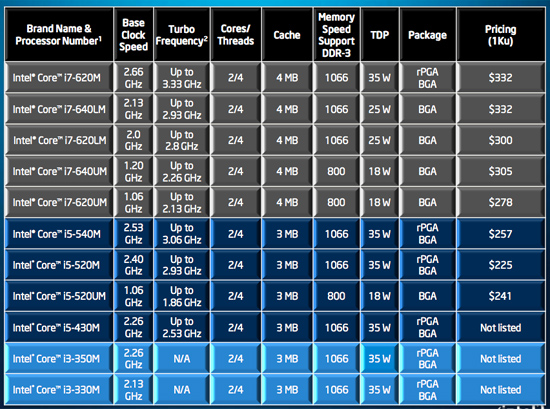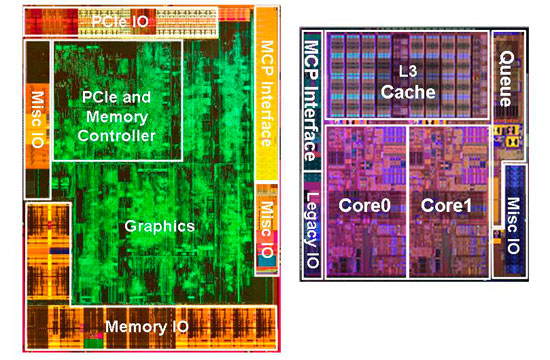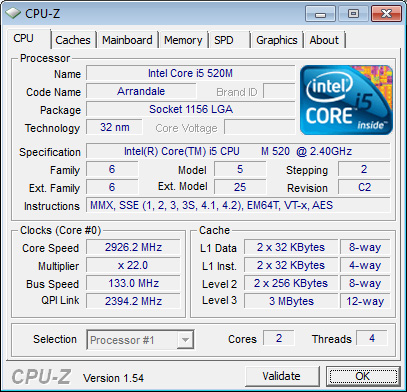Apple's 15-inch Core i5 MacBook Pro: The One to Get?
by Anand Lal Shimpi on April 14, 2010 10:38 PM EST- Posted in
- Mac
- MacBook Pro
- Arrandale
- Core i5
- Laptops
Faster, Not Slower
The 15-inch and 17-inch MacBook Pros offer your choice of Core i5 or i7 processors. If you follow Intel’s model numbers, you can get either a Core i5 520M, 540M or Core i7 620M. These chips run at 2.40GHz, 2.53GHz or 2.66GHz by default.
Wait! But the old 15-inch MacBook Pro ran at 2.53GHz, 2.66GHz or 2.80GHz by default. These new models are slower! After reading that a few times online yesterday, I knew it was time for a quick refresher on microprocessor architecture and performance.

Intel's Arrandale Lineup
There are three ways we can improve CPU performance these days: increase clock speed, increase IPC or increase thread count. The first improvement is the obvious one. Keep all other variables the same, just make the chips run at a higher frequency. The second one requires that we increase the amount of work our CPU does in each clock cycle (increasing the number of instructions completed per clock, or IPC). And the third one is to simply increase the number of simultaneous threads our CPU can handle, either through multiple cores or multiple threads per core.
With Arrandale, the mobile Core i5 and i7, Intel actually used all three tricks to improve performance.
I’ll start with the middle improvement: increasing IPC. Arrandale brings a dual-channel memory controller on-package (it’s actually on the GPU and not the CPU as you may remember). This improves bandwidth which in turn keeps the CPU cores fed with data and thus increases overall IPC.

The Arrandale die. Graphics on left, CPU on right.
The cache hierarchy has changed quite a bit since the Core 2 days. Instead of a large shared L2 cache, each of the two Arrandale cores have their own private 256KB L2 cache. The cache is the fastest of any desktop CPU today requiring only 10 cycles to access it. As I wrote in the past, the L2 is quickly becoming the new L1 so low latency access matters more than size. The catch-all cache moves down a level and Arrandale has a large 4MB L3 cache. On the Core i7s you get the full 4MB, while the i5s disable 1MB leaving you with 3.

There are some instruction and execution level improvements as well, which I’ve detailed here and here. Specific to Arrandale (and the rest of the Westmere family) are new AES instructions designed to accelerate encryption/decryption operations.
The takeaway here is any slight drop in default clock speed is at least partially negated by the increase in performance per clock. If that’s not enough, Arrandale also brings Turbo Boost to Intel’s mobile chips.
These Core i5 and i7 processors have about a million transistors dedicated to power management. It’s a little section of the CPU called the PMU (Power Management Unit). The PMU monitors CPU temperatures, current draw and power consumption. Based on these inputs as well as the current load on the CPU, the PMU can tell the rest of the CPU to increase its clock frequency. The CPU is allowed to increase its operating frequency in 133MHz steps up to a predefined max speed. The max speed is determined by Intel as well as the number of cores that are actively doing work on the chip.
The whole process works like this. If you have all cores active and the workload they’re running isn’t maxing out the CPU’s specified current or power draw, the cores can run at a higher frequency. If you have only one core active, the other core is power gated (effectively shut off) and the active core is allowed to turbo up several bins as long as it remains within its current, temperature and power limits.
The result is that most of the time your 2.40GHz Core i5 runs at 2.66GHz, and if you’re only running single threaded applications you’ll see it bounce from 2.66GHz to 2.80GHz and 2.93GHz. So even if the IPC improvements brought on by Arrandale weren’t enough, you’ll rarely run at your base clock speed when you need the performance. Intel’s Turbo Boost works beautifully in practice and the transition to OS X seems to have gone well.

The 2.40GHz MacBook Pro running at 2.93GHz thanks to Turbo
The final vector for performance improvement is by increasing the number of threads your CPU can work on at once. Threads are nothing more then collections of instructions, which themselves are the basic work units of any CPU. The more threads you can actively complete in parallel, the higher your overall CPU performance.
All Arrandale based Core i5 and i7 CPUs are dual-core processors, that’s two threads right there. Each core however can work on two threads at the same time thanks to Intel’s Hyper Threading bringing us up to four total threads on the new MacBook Pro. Two of those threads are virtual and are simply designed to occupy any idle resources on a core. Hyper Threading doesn’t give the same performance boost as you’d get from four cores, but what it does give you is better-than-dual core performance without the power requirements of four physical cores. For a notebook designed with portability in mind, the tradeoff is ideal.

The downside to all of this? Only the 15-inch and 17-inch models get Arrandale, the 13-inch MacBook Pro sticks with the old Penryn derived Core 2 Duo architecture. If you were holding out for a 13-inch Arrandale model, you’ll have to keep waiting.
| Apple's 2009 Lineup | 13-inch MacBook Pro (Early 2010) | 13-inch MacBook Pro (Late 2009) |
| CPU | Intel Core 2 Duo 2.40GHz | Intel Core 2 Duo 2.26GHz |
| Memory | 4GB DDR3-1066 | 2GB DDR3-1066 |
| HDD | 250GB 5400RPM | 160GB 5400RPM |
| Video | NVIDIA GeForce 320M (integrated) | NVIDIA GeForce 9400M (integrated) |
| Optical Drive | 8X Slot Load DL DVD +/-R | 8X Slot Load DL DVD +/-R |
| Screen Resolution | 1280 x 800 | 1280 x 800 |
| USB | 2 | 2 |
| SD Card Reader | Yes | Yes |
| FireWire 800 | 1 | 1 |
| ExpressCard/34 | No | No |
| Battery | 63.5Whr | 60Whr |
| Dimensions (W x D x H) | 12.78" x 8.94" x 0.95" | 12.78" x 8.94" x 0.95" |
| Weight | 4.5 lbs | 4.5 lbs |
| Price | $1199 | $1199 |










114 Comments
View All Comments
n0dder - Friday, April 16, 2010 - link
Would you say that the increased working temperatures in the new MacBooks prohibits its use as a real Laptop? I'm currently using a rev 2.1 MacBook (2.16GHz), and spend 3-6 hours with it in my lap every day, and while it gets too hot if I stress it, surfing the web and doing light work is fine - if the new MBP's run hotter than that, I guess that I shouldn't have waited this long, but have gone for the previous model.TIA,
Terry1 - Saturday, April 17, 2010 - link
On page 5 of Anand's review, he notes that OS10 manages the switching between imbedded graphics and the Nvidia board. No user control apparently provided. Question: what happens when you are running bootcamp with Windows 7 as second operating system? Is OS10 lurking in the background to keep this process functioning, or (my concern) does the system just default to the imbedded GPU mode?Terry1 - Saturday, April 17, 2010 - link
RE my prior post it looks like I missed this comment in the review: "Despite using a NVIDIA GPU, there's no support for Optimus under Windows 7 on the new MacBook Pro. The GeForce GT 330M is always in use there regardless of whether you use an Optimus enabled driver or the 196.21 driver that comes with the MacBook Pro." That's the way I would want it given manual control is impossible, but has this been verified by a user/tester?PubicTheHare - Sunday, April 18, 2010 - link
Anand said to wait until the next revision of Arrandale if we want cooler laptops."Next revision of..." meaning these new MBPs are Arrandale?
If they are (I'm assuming Arrandale is 32 nm), then what would the next revision bring to equate to cooler machines?
I'm disappointed in the heat issue. My Santa Rosa MBP (early 2008) runs hot as hell, especially when I watch YouTube but even if I'm not running video or flash. It bugs me.
I won't upgrade until:
1) OS X supports TRIM (so I can throw in a Crucial C300 SSD or higher capacity Intel G2)
2) USB 3.0 or Lightpeak is available on the MBP
3) The laptops run cooler with discrete graphics
I was really hoping to upgrade this time...
BillyboyPC - Tuesday, April 20, 2010 - link
These MacBooks will be perfect with more affordable SSDs and USB 3. Until then, it's still a no-go for me.R0N1 - Wednesday, April 21, 2010 - link
Great article, but at least one aspect not mentioned:All the Arrandale chips mentioned are the standard voltage M version with 35W TDP. True, this TDP also includes integrated GPU, but still: 35W is a lot for a laptop.
The 18W 640UM, 620Um & 540UM are probably "reserved" for new MacBook Air,
But it would surly be beneficial for MBP to use the 25W LV parts (current lineup lists i7 620LM & 640LM) - any chance Apple would consider using them in MBP?
After all, all the Penryn P series CPUs are medium voltage 25W TDP chips, compared to cheaper (per MHz) T series standard voltage 35W ones.
The new Arrandale revision you mentioned - is this really silicon respin supposed to trim excessive power from the standard voltage M chips, just production process improvement or merely chip binning?
Thanks.
jvin85 - Friday, May 7, 2010 - link
Anand Lal Shimpi,I didn't see any mention about the memory difference for the Geforce GT 330M. I was wondering what differences the extra 256MB makes.
I'm considering upgrading as I use an early 2008 MBP. Back then going for the better graphics card was always a big debate. I am wondering if it truly makes a difference in these models.
Thanks.
Kathi - Wednesday, August 18, 2010 - link
I am thinking about bying a 13″ because I like the size and it would be perfekt for me. But I prefer the new i5 processor. Do you think there is a chance that there will come a new 13″ with the i5 processor? Soon? I don´t want to wait too long, but it would be stupid if a new version comes out just after I bought one…xxunrealdudexx - Friday, August 20, 2010 - link
Heading off to Uni in the fall but can't decide between 13" or 15". Which should I get? I'm in the BBA program so I don't think ill be needing Photoshop/Final Cut/etc.?? And I would like it to last for the full 4 years at least. Thanks guys!juhku - Friday, September 3, 2010 - link
Great article! Thanks!Any new information about Arrandale update to get the MacBook run cooler? Is it happening and when?